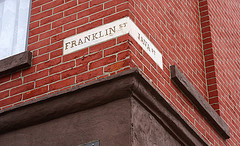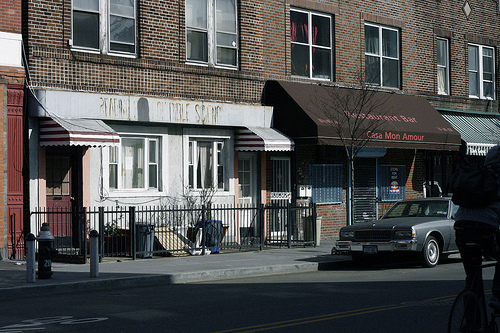What’s Wrong With Franklin Street?

Photo: vidiot on flickr
Jeremiah takes a walk down Franklin Street and doesn’t exactly like what he sees. Things like “outdoor cafes packed with wafer-thin women cradling chihuahuas in their laps, bars with clever names, ‘craft brew’ beer stores [where is that?], and coffee shops filled with bearded men peering at Mac laptops through chalk-white Wayfarer shades.” In short, everything he saw as authentic on his tour of Manhattan Avenue is threatened by the renaissance of Franklin Street.
Personally, I think the dichotomy of Manhattan Avenue and Franklin Street is a fascinating – and so far positive – urban study. Yes, Franklin Street is gentrifying, but what’s interesting is that it is not gentrifying at the expense of Manhattan Avenue. The two really exist as parallel universes. Nor is the gentrification of Franklin Street pushing out local stores. 100 years ago, Franklin Street was filled with locally-owned ground-floor retail stores. Ten years ago, most of Franklin Street was not retail – the old storefronts were vacant or had been converted to apartments. As new people came into the neighborhood looking to open businesses, they found a ready stock of underutilized commercial space. The same thing has been happening along Grand Street west of the BQE – storefronts that had been vacant for decades are suddenly being reborn as bars, restaurants, boutiques, bicycle shops, book stores and much more. Local businesses owned by local residents, and by and large, none of it is displacing older businesses.

Layers of history – former storefronts that had been bricked in are now being reopened.
Photo: ashfordesign on flickr
This is exactly the kind of development most urbanists would love to see. And it came about not through some planner drawing a line on a map, but rather as a result of a series of individual decisions, all of which started with a recognition of a quality, underutilized building stock. Instead of boarded up storefronts, it’s eyes on the street in the classic Jane Jacobs sense. It’s economic development from the bottom up. It’s more local jobs where none had existed for decades. It’s more income for building owners, many of whom are also locals (and long-timers). Sure it’s (generally) serving one segment of the population, but it can be benefitting many segments. And sure it’s a fragile ecosystem that needs to be carefully nurtured. It could all go to pot and become Soho, or expand east to Manhattan Avenue and displace long-time businesses there.

You wrote: Instead of boarded up storefronts, it’s eyes on the street in the classic Jane Jacobs sense. It’s economic development from the bottom up. It’s more local jobs where none had existed for decades. It’s more income for building owners, many of whom are also locals (and long-timers).
I beg to differ, my dear. Let’s deconstruct the latter most photograph you selected for this post:
To the left: a defunct storefront being used as residence.
To the right: a restaurant that was operated by someone who worked at business operated on the waterfront: both are defunct.
Businesses that is.
Bars and retail businesses (many of whose proprietors I know and hold in high esteem) do not compensate for the jobs lost in this area. Jobs lost because businesses were forced to move elsewhere due to high rents/rampant over-development/overall greed.
Jobs which provided benefits and a chance at advancement. Show me one shop clerk, barista or bartender who has health insurance on Franklin Street and I’ll call him/her an anomaly.
To invoke Jane Jacobs is downright laughable. To call this progress is questionable. Unless you’re taking into consideration the profits being reaped by landlords and developers; a proliferation of bars and bullets riddling your front door:
http://www.newyorkshitty.com/?p=14776
Your friend up north.
You miss my point – 10 years ago there were no stores here, so there were no jobs. You might not like baristas, but most of those baristas are incremental jobs to the neighborhood. I chose that photo to show what had happened to storefronts on Franklin over the past 50 years – they were almost all shuttered. Over the past 5+ years, many have reopened, adding jobs to the neighborhood while not displacing jobs or businesses on Manhattan Ave.
The loss if manufacturing jobs is a different question economically and geographically – neither this new retail nor the new pharmacies, banks and chain coffee shops (all of which are going in on Manhattan Ave.) will replace that quality of jobs. And it was the stroke of a planners pen that put the fork in those jobs – though they had been disappearing for years.
What IS an issue on the manufacturing front is that the City’s zoning code allows uses like bars and hotels in manufacturing zones. Industry can’t compete with these businesses on rent, so they get displaced. The worst actors bar-wise are in the small remaining M zones.
thanks for the well-considered rebuttal. i actually like your optimistic vision, and i don’t totally disagree with it. but looking at those lovely, indie shops and bars, etc., is like looking at crack. or chocolate cake. you know, if it could just stay like this–a small taste–it would be okay, even pleasant. but it won’t stay small. it is the beginning of a slippery slope into destruction. and knowing that makes it hard for me to really enjoy it.
also, as heather points out, how much did it come at the expense of the disenfranchised folks who were there before? was it all just long-empty storefronts? something to think about.
thanks for the link and for engaging in the conversation.
p.s. the craft brew place is “brouwerij lane”
Thanks Jeremiah. I do think that the majority of the new stores, etc. did not displace existing stores. Some may have displaced residents, but the residential use was in most cases probably illegal (the storefronts were grandfathered retail – unless an owner changed the CO, which didn’t happen often, residential is contrary to the CO). What makes this a good story for me is the fact that the new stores did NOT displace existing retail, and in fact seem to coexist with Manhattan Avenue in a strange symbiotic retail world.
But I do agree that its a slippery slope – a fragile ecosystem, as I put it. There’s not a lot to be done to protect it, either, though the economy may at least give some breathing room to think about it. Also, as I said in response to Heather, getting rid of the obnoxious bars in the M zone would help turn the volume down a bit.
I have to try brouwerij lane. Thought it was just a bar, but clearly its much, much more.
Don’t listen to Miss Heather. I used to be a loyal follower of her blog when it was genuinely funny and unique, but now it’s obnoxious post after obnoxious post of re-hashing the same complaint about development and how she’s the only one “saving” Greenpoint by taking pictures of dog shit — don’t we want that kind of material to *not* define where we live? — and reporting stuff to the D.O.B. that turns a blind eye.
As a neighborhood native, I’m really thrilled that there’s finally an English-language bookstore in Greenpoint (WORD) and restaurants off the beaten path that serve healthful food instead of kielbasa cooked in lard. The shooting that took place at the Production Lounge is unacceptable — and I was there at the community meeting at the Greenpoint Savings Bank to speak against places like that — but it’s a far cry from the crime that used to take place in that area of Greenpoint before a few entrepreneurs decided to give Franklin Street a chance.
Miss Heather: you’re an idiot, my dear. Blaming the coffee shops on Franklin St for driving out manufacturing that has mostly been gone for 30 years is beyond stupid. They replaced empty storefronts.
I’m sure you yourself, newcomer that you are, would not be in Greenpoint if it was still a blue collar manufacturing area, so get off your soapbox.
Bingo, there’s a lot of hot-headedness about these issues (with good reason, sometimes), but let’s keep things in proper perspective – the development of Franklin St from shuttered spaces to what it is now is not “the beginning of a slippery slope into destruction.” Destruction? Really? Hyperbole is an ugly truth some people should learn to recognize in themselves.
I have lived in Greenpoint for 62 years and its nice to see new places open. The new ones are replacing the old stores the old mom and pop places with a new type. What gets a lot of people a little mad is the young people that come to Franklin street are from out of state, and not known to the poeple that have lived here all there lives. One thing that really bothers me is the way Williamsburt is trying to make Greenpoint part of Williamsburg as in the zip 11211 we are 11222. Lets please keep 11211 in Williamsburg and 11222 in Greenpoint.